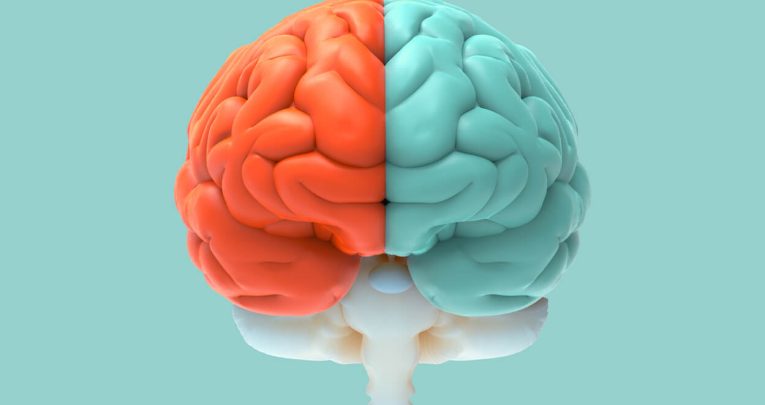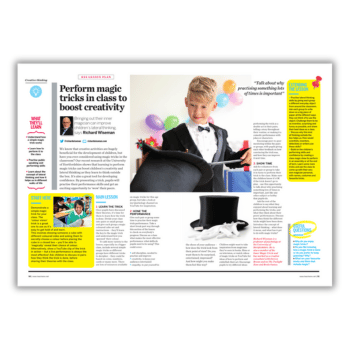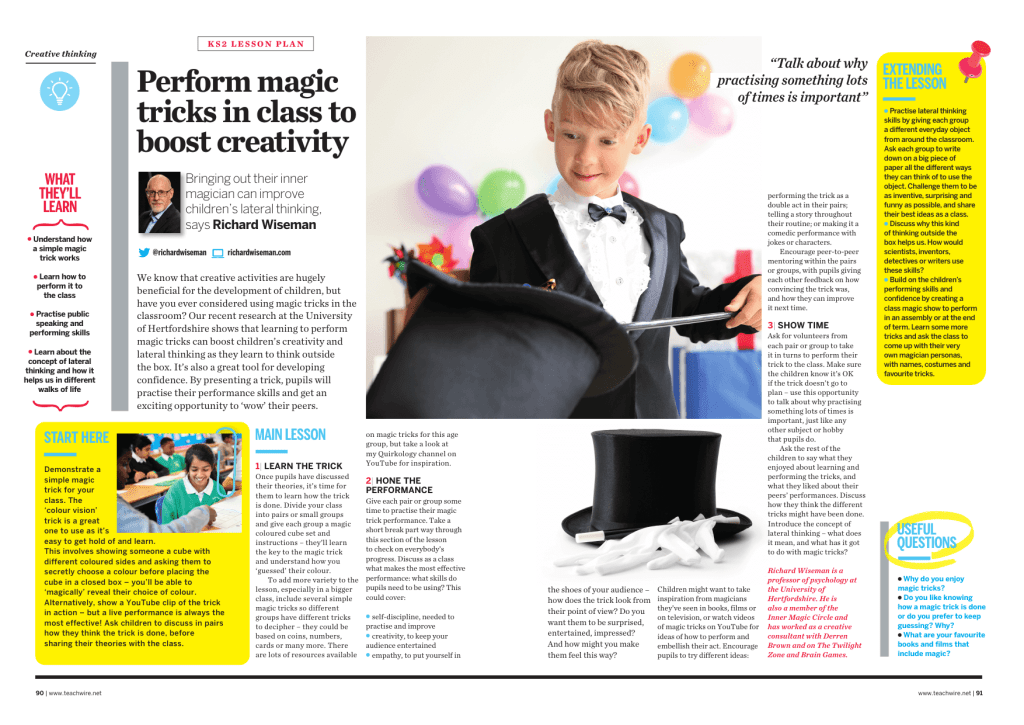Creative thinking – Can we teach it in school, and if so, how?

We dive into whether teaching creative thinking in schools is possible, and if so, how we can make it happen in the classroom…

- by Teachwire
- Classroom expertise and free resources for teachers

We explore whether it’s possible to effectively teach creative thinking skills in school and discuss potential strategies for integrating it into your everyday teaching…
What is creative thinking?
The Personal Learning and Thinking skills framework was an ultimately ill-fated attempt to outline the qualities, skills or attributes needed for success in learning and life. However, it usefully defined creative thinking as follows:
- generating ideas and exploring possibilities
- asking questions to extend thinking
- connecting your own and others’ ideas and experiences in inventive ways
- questioning your own and others’ assumptions
- trying out alternatives or new solutions and following ideas through
- adapting ideas as circumstances change
Why is creative thinking important?
Thanks to the rapid adoption of new technologies, we’ve all had to become used to living in a world characterised by constant and rapid change.
Creativity can help with adapting to such change. With the considerable number of social and ecological problems we face that will require creative solutions, it’s increasingly important that we find ways of educating children that don’t limit the natural creativity they were born with.
Schools need to concentrate on further developing children’s skills at thinking creatively, and finding space for them to entertain imaginative possibilities alongside the learning of facts.
This will create children readily able to apply facts in the process of solving practical problems.
Can creative thinking be taught?
Authors Pedro De Bruyckere, Casper Hulshof and Liese Missinne set out their stable on this important question…
Creativity is not a general, overarching skill. In fact, creativity is not really a skill at all. It’s more a human quality or ‘trait’, which we cannot learn to any significant degree.
This is in contrast to the more influenceable ‘states’, which are personality characteristics that remain relatively stable over time.
But although creativity is very difficult to learn, it doesn’t mean we can’t stimulate what a person already possesses by organising the best possible environment.
“Although creativity is very difficult to learn, it doesn’t mean we can’t stimulate what a person already possesses”
Smith and Firth (2018) offered the following definition of creativity: ‘The ability to create something, ideally something that is useful or entertaining in some way. Typically, this is going to involve a rearrangement of existing parts or concepts (words, musical notes, mathematical notation, etc.) rather than making something completely new and unrecognizable.’
In other words, creativity is about making new and useable combinations of existing information. Viewed in this way, we can’t consider creativity in isolation from domain-specific knowledge and skills.
Teaching creativity
So the short answer to the question of whether you can teach creativity is no. But we can stimulate it and bring it to the surface by creating the right conditions.
“The short answer to the question of whether you can teach creativity is no”
The good news is that most research has confirmed that we become more creative as we get older. This is only logical, since by then we have acquired much more domain-specific knowledge. This is what you need to be qualitatively creative.
Does this mean that basic knowledge is less important and that we no longer need it? Far from it! This is a major misconception: we still need to teach this crucial domain knowledge to our children and young people. It is the first important step on the way to improving their creativity in the long run.
In summary (and based on a broad vision of creativity): without knowledge there can be no creativity (probably).
The Psychology of Great Teaching, by De Bruyckere, Hulshof & Missinne is out now (£22.99, Sage).
Lateral thinking lesson plan

Bringing out their inner magician can improve children’s creative thinking. Use this KS2 lateral thinking lesson plan from Professor Richard Wiseman to help students learn to think outside the box.
How to develop creative thinking in students
Make connections between different domains of knowledge
For example, when teaching about the planets (science), let your children also calculate the distance and size of them (maths). Or combine maths with the concept of a timeline in history.
Create a psychologically safe learning climate
Children must feel confident to experiment and think ‘out of the box’ without the possibility of their teachers or classmates criticising them or laughed at them. They must have the courage to take risks, make mistakes and be themselves.
One way to do this is to ensure that you don’t mark creative tasks with points or grades. Stress to ‘perform’ can limit a creative spirit.
As a teacher, also ensure that classmates don’t harshly criticise or ridicule other students. They must be free to exchange ideas, however seemingly bizarre, without fear. Establish an atmosphere where everyone values and appreciates out-of-the-box thinking.
Invest in ‘away time’
Our minds need a certain amount of away time, time when we do not need to concentrate or be attentive. Make sure that your pupils have sufficient time to be ‘unaware’ or ‘absent’.
This kind of ‘time-out’ is not only useful for allowing our brains to relax, for processing emotions and for putting things in perspective but also helps to bring our creative inspiration to the surface.
Creative ideas often emerge when you least expect it: under the shower, during a walk, tidying up your room, just doing nothing. Free time is not wasted time.
With this in mind, allow your pupils sufficient play breaks, quiet moments, chat time, etc. It is an illusion to think that children and young people can concentrate non-stop throughout a 50-minute lesson.
Encourage daydreaming
During periods of away time, encourage pupils to clear their heads and let their minds wander. This kind of random and fragmentary thinking stimulates creativity.
Encourage sufficient sleep
This is not always easy with children and young people but it is a crucial factor. After your REM sleep (the dream phase), you reach a kind of hyper-associative state. This is where your thoughts are given free rein, some of which resurface in your waking hours.
Like daydreaming, night-time dreaming is also good for your creativity (Smith & Firth, 2018).
Develop routines and habits
Developing an automatic approach to certain tasks (like your morning routine or cooking a meal that you have cooked a hundred times before) means that you no longer have to think about them consciously, so that you once again free up capacity in your brain for the kind of thinking that can lead to creativity (De Bruyckere, 2018).
Try concept-based learning
Throw the right kind of spanner into the works with concept-based learning, says Jonathan Lear…
For as long as I can remember, the majority of primary schools have adopted a topic-based approach to curriculum design.
An example of this from my own school would be a Y6 geography topic we called ‘The force of nature’.
After coming up with the jazzy topic name, we set about looking for cross-curricular links. When we had sufficiently joined up our topic map, we then thought about the outcomes that we’d want the children to produce.
It’s a pretty traditional way of working, but after reflecting on this process, it struck us that while it was undeniably a creative approach, it was all about our creativity rather than the children’s.
“It struck us that while it was undeniably a creative approach, it was all about our creativity rather than the children’s”
To get to grips with this imbalance, we developed the idea of concept-based learning – a curriculum model framed around an enquiry process.
In terms of curriculum coverage, not a lot changed. In this geography example, we still covered volcanoes and earthquakes, but rather than immediately go for cross-curricular links, we instead identified philosophical concepts that we could explore through that particular bit of curriculum:
Curriculum content: earthquakes, volcanoes, natural disasters
Concepts: resilience, adversity, change, equality, strength
Following this, we used the concepts to make connections with other curriculum areas. If we were looking at art for example, then I can leave behind the papier-mâché volcano and instead use any artworks that explore one or more of the concepts.
Equally, in English, rather than scrape around for a high-quality text about natural disasters, I could go for any book that dealt with themes of adversity, change, or any one of the other concepts.
To complete the process, we then created an enquiry question that would frame the concepts and give the children a starting point for their enquiry.
Concepts: resilience, adversity, change, equality, strength
Enquiry question: does adversity always make us stronger?
Differences to a topic-based approach
In terms of the children’s ownership, this is not dissimilar to the process we went through before. It’s still the teacher who comes up with the concepts and enquiry question, not the children.
The key difference between this and a topic-based approach, however, is in what happens when the enquiry begins.
Rather than being passive recipients of our creativity, the children are actively involved from the outset. The enquiry question is specifically designed to encourage more questions and thoughts – something that continues throughout the process.
“Rather than being passive recipients of our creativity, the children are actively involved from the outset”
As individual subject disciplines are developed and the children become more knowledgeable, they have the opportunity to explore the concepts, generate ideas, challenge assumptions and deepen their understanding, all while making connections between what they know and their broader understanding of the world.
Developing this model hasn’t guaranteed the development of creative thinking, but it has created the foundations and, if nothing else, it’s repositioned the children as the ones who need to do the thinking rather than us.
Jonathan Lear has worked in inner city schools for over 20 years as a teacher and deputy. He is a speaker and Associate of Independent Thinking. His book, The Monkey-Proof Box: Curriculum Design for Building Knowledge, Developing Creative Thinking and Promoting Independence, is published by Independent Thinking Press.
Try the paper clip test
Alice Guile explains how to replicate a pioneering psychological study in your classroom…
As an art teacher, I’ve designed and taught a lesson themed around George Land and the paper clip test (imagining as many alternative uses for a paper clip as you can). The lesson includes actually carrying out the test itself.
I allow children to work alone or in groups, and have completed it with several different age groups. The results I’ve seen so far are largely in keeping with the results of the original study, with younger children tending to perform better.
My best group managed to devise nearly 150 alternative uses for a paper clip – though what was interesting about this group was that it contained a neurodiverse child who had autism and ADHD.
During the lesson, this student would randomly shout out the craziest suggestions he could think of in an almost hyperactive way, with apparently no regard for whether his ideas were practical or realistic.
The group also included a pair of identical twins whose family had recently relocated from Germany. They not only wrote everything down in a highly focused, diligent way, but also came up with a system for increasing their creative ‘productivity’.
When the student with ADHD shouted something along the lines of “You could post the paper clip to China!”, the twins would write quotation marks beneath the words ‘You could post…’ on successive lines to indicate repetition, followed by the names of every country they could think of.
They then developed this idea over several variations with further ideas, such as ‘You could give the paperclip to… [insert celebrity’s name]’ or ‘You could mine for… [insert gemstone here]’ .
Via this system, they generated many different ideas in a relatively short space of time.
ADHD and creative thinking
Studies have shown that the propensity to distraction exhibited by individuals with ADHD can result in them coming up with more creative ideas.
That student of mine lacked the attention span needed to write any of his ideas down, but he was lucky enough to be working alongside two highly organised and efficient students who could.
Those students’ organisational skills may have simply been down to their innate personalities. Though having grown up in Germany – a country famed (or perhaps stereotyped) for valuing efficiency and organisation, could their upbringing and prior education have affected the way they approached the task?
“The propensity to distraction exhibited by individuals with ADHD can result in them coming up with more creative ideas”
The paper clip study did show, after all, the extent to which the education we receive can affect the way we think.
What my own anecdotal observations seem to show is the power of allowing divergent, creative thinking to take place first, before then being recorded by convergent, organised thinking taking place immediately afterwards.
Were it not for the child with ADHD, the twins might have had far fewer ideas to draw upon. Without the twins, the student with ADHD would have had little evidence to show for his creativity. Together, they were far more successful than any other group.
Neurodiversity
The activity has prompted me to talk to the students about neurodiversity, and how it can play a role in helping some people to be more creative.
The student in question, and then another, chose to explain to the class that they had autism/ADHD, and presented this as something they were proud of and content to share with their peers.
It was an outcome that made me, as their teacher, very happy, considering how some students with learning difficulties may come to view their neurodiversity as a bad thing.
We also discussed the importance of being able to have creative ideas within the workplace, such as when thinking up new product ideas.
Overall, I’ve been pleased with how my ‘paper clip creativity test lessons’ have gone, and look forward to doing them again.
Not just because they actively encourage students to think more creatively, but also because any neurodiverse students may find themselves faring better at the tasks than average, when they may struggle more than their peers with many other aspects of school.
“Any neurodiverse students may find themselves faring better at the tasks than average”
I would strongly recommend that other teachers, and also parents, perform similar activities of their own. You could potentially attempt the task with any number of other everyday objects, such as a brick or a toothbrush.
Do it alongside your children and see who scores the highest. Because if we can encourage children to develop their imaginative skills today, then there’s a higher chance of them being able to solve some of the urgent and complex problems of tomorrow.
Alice Guile is a secondary school art teacher.







